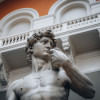Michelangelo: Marble, paint and divinity

Michelangelo once expressed in one of his poems, "I know I am ugly."
Not only was he insecure about his physical and facial appearance, family background, and sexuality, but also had a notorious reputation for his volatile temperament. Despite, or maybe because of how these affected his sense of self and psyche, especially at a younger age, he would eventually spend his life in pursuit of sublime perfection, becoming one of the most influential and greatest artists in human history.
It is difficult to encapsulate the aura of his masterpieces within words; one has to be physically present in front of his art pieces to be engulfed by their essence. Nonetheless, on the occasion of his 567th birthday (March 6), this is a humble attempt to briefly introduce and reminisce about one of the quintessential Renaissance men.

Michelangelo di Lodovico Buonarroti Simoni was born on March 6, 1457, in the small village of Caprese (now known as Michelangelo Caprese in his honour), near Arezzo, Tuscany, Italy. After his mother passed away from prolonged illness when he was only six, his father unwillingly placed him in primary care with a nanny, who was from a stonecutter family. Spending his childhood in this family led to the foundation of Michelangelo's lifelong love affair with marble. In fact, despite being a polymath who revolutionised the 'Mannerism' style in painting and architecture, a poet, an engineer, and the chief architect of St Peter's Basilica, he always preferred to be addressed primarily as a sculptor.
Teenage Michelangelo used to skip school and spend time in churches observing the painters. It was evident that he had no interest in his biological family's vocation, which was never appreciated initially. However, within a few years, the prodigy discovered himself in the Humanist Academy of the powerful Medici family, who were the rulers of Florence at the time and notable art patrons of the Renaissance era. The academy was a life-changing experience for young Michelangelo; it was also when he had access to study cadavers at the convent's hospital, this passion for learning about human anatomy and obsession for perfection soon carved his path into becoming arguably the first superstar artist.

Michelangelo's list of magnum opuses includes his most famous amongst the Pietas, "La Madonna Della Pieta" (1498-99), which depicts the body of Jesus in the lap of Mother Mary after the Crucifixion. "David"(1501–1504), which is arguably the greatest ever sculpture ever carved. Last, but not the least, one of the most recognised pieces of his art that even morphed into contemporary pop culture is "The Creation of Adam" (1508–12), which is part of the majestic frescoes that he created at the ceilings of The Sistine Chapel.
Constructive discussions about Western art in the contemporary world will always include debates about colonialism, imperialism, capitalism, religion. Yet, only tales of the Renaissance are etched into the minds of the masses instead of other relevant art histories (for example Asian art history) that will help us understand the history of art and human civilisation in a better way. However, despite everything, if there is one lesson to be inspired by the life of Michelangelo, it is that talent is nothing without a work ethic. The man who knew how to permanently summon divinity into his worldly works from Eden was still working at the age of 88 when he passed away.
I would like to end with a quote from Il Divino ("the divine one" as regarded by his peers) himself: "Genius is eternal patience."

 For all latest news, follow The Daily Star's Google News channel.
For all latest news, follow The Daily Star's Google News channel. 





Comments